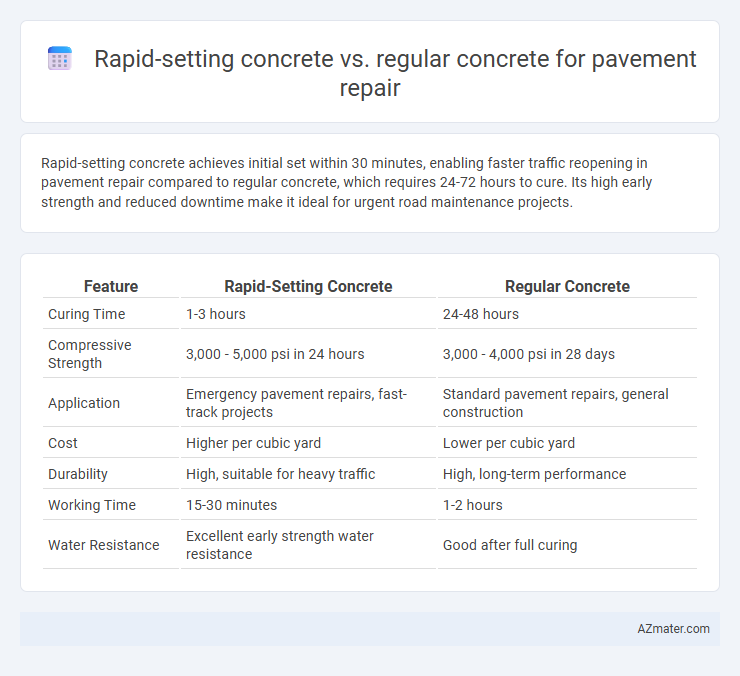Rapid-setting concrete achieves initial set within 30 minutes, enabling faster traffic reopening in pavement repair compared to regular concrete, which requires 24-72 hours to cure. Its high early strength and reduced downtime make it ideal for urgent road maintenance projects.
Table of Comparison
| Feature | Rapid-Setting Concrete | Regular Concrete |
|---|---|---|
| Curing Time | 1-3 hours | 24-48 hours |
| Compressive Strength | 3,000 - 5,000 psi in 24 hours | 3,000 - 4,000 psi in 28 days |
| Application | Emergency pavement repairs, fast-track projects | Standard pavement repairs, general construction |
| Cost | Higher per cubic yard | Lower per cubic yard |
| Durability | High, suitable for heavy traffic | High, long-term performance |
| Working Time | 15-30 minutes | 1-2 hours |
| Water Resistance | Excellent early strength water resistance | Good after full curing |
Introduction to Pavement Repair Methods
Rapid-setting concrete offers significant advantages over regular concrete in pavement repair due to its accelerated curing time, allowing faster reopening of roads and minimizing traffic disruptions. Its high early strength development makes it ideal for emergency repairs and high-traffic areas requiring quick load-bearing capacity. In contrast, regular concrete requires longer curing periods, which can extend downtime and increase maintenance costs.
What is Rapid-Setting Concrete?
Rapid-setting concrete is a specialized formulation designed to achieve high strength within hours, enabling quicker pavement repair and minimal downtime. It incorporates chemical accelerators and cementitious materials that significantly reduce the curing time compared to regular concrete, which typically requires 28 days to reach full strength. This fast hardening property makes rapid-setting concrete ideal for urgent repairs in high-traffic areas where extended closures are not feasible.
Overview of Regular Concrete
Regular concrete for pavement repair is a mixture of cement, water, aggregates, and admixtures that cures over 28 days to achieve full strength. It offers durability, long-term performance, and resistance to heavy loads and weather conditions but requires extended curing time before traffic can resume. Due to its slower setting time compared to rapid-setting concrete, regular concrete is often used for projects where time constraints are less critical.
Key Differences in Composition
Rapid-setting concrete for pavement repair contains higher proportions of calcium aluminate or special cementitious compounds that accelerate hydration, enabling strength development within hours compared to the days required by regular Portland cement concrete. It often incorporates finer aggregates and chemical additives like accelerators and shrinkage reducers to enhance early strength gain and reduce curing time, while regular concrete relies on a standard blend of Portland cement, water, sand, and coarse aggregates. These compositional differences dictate rapid-setting concrete's suitability for time-sensitive repairs where quick reopening to traffic is critical, unlike regular concrete which emphasizes long-term durability and slower curing.
Setting and Curing Times Compared
Rapid-setting concrete achieves initial set within 30 minutes to 1 hour, enabling traffic reopening often in 2 to 4 hours, while regular concrete requires up to 24 to 48 hours for initial set and 7 days or more for substantial curing. The faster hydration process in rapid-setting mixes is enhanced by chemical accelerators, significantly reducing downtime for pavement repairs. Regular concrete undergoes slower curing, gaining strength gradually over 28 days, making rapid-setting concrete ideal for urgent repair projects needing minimal disruption.
Durability and Longevity Factors
Rapid-setting concrete offers enhanced durability and longevity for pavement repair by achieving high early strength within hours, reducing downtime and minimizing exposure to traffic-induced stress during curing. Its superior resistance to freeze-thaw cycles, chemical attacks, and abrasion ensures long-lasting performance compared to regular concrete, which typically requires 28 days to cure and may be more susceptible to early damage. The accelerated hydration process in rapid-setting concrete creates a denser microstructure, improving overall pavement resilience in harsh environmental conditions.
Cost Implications and Budget Considerations
Rapid-setting concrete for pavement repair significantly reduces downtime, leading to lower labor and traffic management costs compared to regular concrete. Although the upfront material cost of rapid-setting concrete is higher, its faster curing time minimizes long-term financial impacts like extended road closures and associated economic losses. Budget considerations should weigh the balance between initial expenses and the overall cost savings from quicker project completion and enhanced return-to-service timelines.
Ideal Applications for Each Type
Rapid-setting concrete is ideal for pavement repairs requiring minimal downtime, such as airport runways, highways, and emergency fixes, due to its quick curing time of 1 to 3 hours. Regular concrete suits projects with ample curing time, like residential driveways and sidewalks, where strength development over 28 days is prioritized for long-term durability. Choosing between the two depends on project time constraints, load-bearing requirements, and environmental conditions.
Environmental Impact and Sustainability
Rapid-setting concrete reduces environmental impact by minimizing construction time and lowering carbon emissions associated with prolonged equipment use and traffic disruptions. Its accelerated curing process allows for quicker pavement reopening, decreasing fuel consumption and air pollution from idling vehicles. Compared to regular concrete, rapid-setting options enhance sustainability through efficient resource utilization and reduced energy demands during the repair lifecycle.
Choosing the Right Concrete for Pavement Repair
Rapid-setting concrete cures significantly faster than regular concrete, enabling quicker reopening of repaired pavement areas and minimizing traffic disruptions. Its high early strength and resistance to freeze-thaw cycles make it ideal for urgent repairs and harsh weather conditions. Selecting the right concrete depends on project timelines, load requirements, and environmental factors to ensure durability and cost-effectiveness in pavement repair.

Infographic: Rapid-setting concrete vs Regular concrete for Pavement repair
 azmater.com
azmater.com